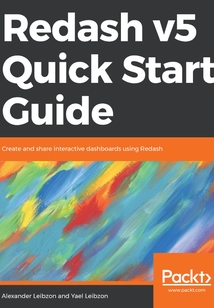舉報(bào) 

會(huì)員
Redash v5 Quick Start Guide
DataexplorationandvisualizationisvitaltoBusinessIntelligence,thebackboneofalmosteveryenterpriseororganization.Redashisaqueryingandvisualizationtooldevelopedtosimplifyhowmarketingandbusinessdevelopmentdepartmentsareexposedtodata.IfyouwanttolearntocreateinteractivedashboardswithRedash,exploredifferentvisualizations,andsharetheinsightswithyourpeers,thenthisistheidealbookforyou.ThebookstartswithessentialBusinessIntelligenceconceptsthatareattheheartofdatavisualizations.YouwilllearnhowtofindyourwayroundRedashanditsricharrayofdatavisualizationoptionsforbuildinginteractivedashboards.Youwilllearnhowtocreatedatastorytellingandsharethesewithpeers.Youwillseehowtoconnecttodifferentdatasourcestoprocesscomplexdata,andthenvisualizethisdatatorevealvaluableinsights.Bytheendofthisbook,youwillbeconfidentwiththeRedashdashboardingtooltoprovideinsightandcommunicatedatastorytelling.
倒序
- 封面
- Title Page
- Copyright and Credits
- Redash v5 Quick Start Guide
- Packt Upsell
- Why subscribe?
- PacktPub.com
- Foreword
- Contributors
- About the authors
- About the reviewer
- Packt is searching for authors like you
- Preface
- Who this book is for
- What this book covers
- To get the most out of this book
- Download the example code files
- Conventions used
- Get in touch
- Reviews
- Introducing Redash
- Data challenges experienced by companies on a daily basis
- An example dashboard
- Ideal tools for targeting challenges
- Meeting Redash
- What exactly is Redash?
- Redash architecture
- Summary
- Installing Redash
- Sizing – choosing the right machine to do the job
- Installation options and installation walkthrough
- Installation options
- AWS-predefined image
- Launching an instance using Redash AMI
- Launching an instance using Bitnami Redash AMI
- Welcome to Redash setup page
- GCE-Predefined image
- Docker-based installation
- Provisioning script installation
- Explaining the setup.sh script
- Troubleshooting
- Configuration and setup
- Email configuration
- Using Google OAuth to log in to Redash
- Redash environment settings
- HTTPS (SSL) Setup
- Permissions in Redash
- Groups
- Creating and editing groups
- Creating users
- Summary
- Creating and Visualizing your First Query
- Creating and testing the Data Source
- Alternative static Data Source definition
- Creating your first query
- Creating the visualization
- Creating the dashboard
- Summary
- Connecting to Data Sources
- Supported Data Sources
- Adding a new Redash Data Source
- A detailed walk-through of the selected Data Sources
- Connecting to PostgreSQL
- Connecting to ElasticSearch
- Connecting to MongoDB
- Connecting to GoogleSpreadsheet
- Connecting to Url
- Connecting to Query Results (beta)
- Connecting to Amazon Athena
- Connecting to BigQuery
- Connecting to Redshift
- Connecting to DynamoDB
- Summary
- Writing and Executing Queries
- Query listing
- Query editor overview
- Query operations
- Creating a query
- Editing a query
- Forking a query
- Archiving a query
- Scheduling a query
- Query results and filters
- Query results
- Query filters
- Parametrized queries
- Parameter settings
- Query snippets
- Alerts
- Alert statuses
- Creating Alerts
- Alert destinations
- Summary
- Creating Visualizations
- The benefits of visualizations
- An overview of visualization types
- Boxplot
- Chart
- Map (Choropleth map)
- Cohort
- Counter
- Funnel
- Map (Markers map)
- Pivot table
- Sankey
- Sunburst sequence
- Word cloud
- Table
- Visualizations in action
- Creating and editing visualizations
- Going over Redash visualizations
- Boxplot
- Chart
- Map (Choropleth)
- Cohort
- Counter
- Funnel
- Map (Markers)
- Pivot Table
- Sankey
- Sunburst sequence
- Table
- Word Cloud
- Special actions on visualizations
- Summary
- Dashboards and Practical Tips
- Dashboard how-tos
- Creating/editing dashboards
- Dashboard query filters hashtags and favorite dashboards
- Dashboard-level filters
- Dashboard hashtags
- Favorite Dashboards
- Sharing dashboards
- Dashboard guidelines
- Tips and tricks
- Summary
- Customizing Redash
- Redash API
- API authentication
- API calls overview
- API usage examples
- Extending Redash code
- Installing Redash for development
- Installing a Docker-based developer environment
- Initial dev setup
- Dev use
- Installing a regular developer environment
- Installing dependencies
- Installing the necessary Python packages
- Node.js packages and assets
- Redash configuration
- Creating Redash operational database tables
- Starting Redash's main processes
- Running tests
- Connecting to the remote server while running the frontend locally
- Summary
- Other Books You May Enjoy
- Leave a review - let other readers know what you think 更新時(shí)間:2021-08-13 15:12:39
推薦閱讀
- Big Data Analytics with Hadoop 3
- Microsoft Power BI Quick Start Guide
- 21天學(xué)通PHP
- Java開發(fā)技術(shù)全程指南
- Hadoop Real-World Solutions Cookbook(Second Edition)
- 傳感器與物聯(lián)網(wǎng)技術(shù)
- Mastering Geospatial Analysis with Python
- SQL Server數(shù)據(jù)庫(kù)應(yīng)用基礎(chǔ)(第2版)
- 數(shù)據(jù)要素:全球經(jīng)濟(jì)社會(huì)發(fā)展的新動(dòng)力
- Generative Adversarial Networks Projects
- x86/x64體系探索及編程
- Raspberry Pi 3 Projects for Java Programmers
- 機(jī)器人手工制作
- Hands-On Artificial Intelligence for Beginners
- Mastering Microsoft Dynamics 365 Customer Engagement
- 中文版Photoshop CS6數(shù)碼照片處理高手速成
- 網(wǎng)絡(luò)互聯(lián)組網(wǎng)配置技術(shù)
- 仿蛇機(jī)器人的設(shè)計(jì)與制作
- Architecting Cloud Computing Solutions
- 中文版Flash CS6高手速成
- AVR單片機(jī)菜鳥進(jìn)階
- Learning AWK Programming
- 操作系統(tǒng)及網(wǎng)絡(luò)應(yīng)用技術(shù)
- Learning OpenStack
- Windows Server 2008系統(tǒng)管理與網(wǎng)絡(luò)管理
- Ubuntu 20.04 Essentials
- Puppet 4.10 Beginner’s Guide(Second Edition)
- UG NX 5.0一冊(cè)通
- R Programming Fundamentals
- 數(shù)據(jù)庫(kù)應(yīng)用基礎(chǔ)(Access 2003)

